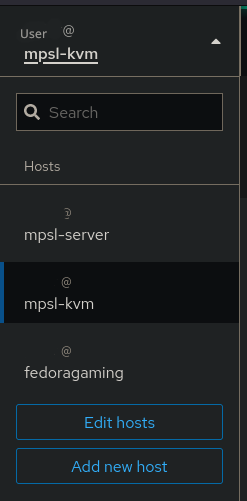I have a couple of home server, both with Proxmox as hypervisor, one VM with Ubuntu 22.04 that does just Docker containers, one with Open Media Vault, one with Home Assistant (HA OS) and a couple of Windows VM to do some tests. Since I wanted to move from OMV, right now I see 2 options:
- stay with Proxmox and find another NAS OS
- use Unraid as NAS and hypervisor
What other option would you suggest?
If you can - separate host and storage. Run what ever hyper visor you like - Xcp-ng is also good. Any nas is good
Debian as OS; LCX/LXD/Incus for containers and VMs. BTRFS as filesystem. More: https://lemmy.world/comment/6507871
What do you mean with
LXD/LXD? Edit: Oh, I got it: LXD/LXC, I’m reading the post you’ve linkedMy bad, typo.
Incus better
Yes, no question there.
I’ve been using unraid for a few years. Super happy with it. Recently migrated from using their normal array to zfs since I got a hold of some enterprise SAS drives.
Been using unraid for a couple of years now also, and really enjoying it.
Previously I was using ESXi and OMV, but I like how complete Unraid feels as a solution in itself.
I like how Unraid has integrated support for spinning up VMs and docker containers, with UI integration for those things.
I also like how Unraid’s fuse filesystem lets me build an array from disks of mismatched capacities, and arbitrarily expand it. I’m running two servers so I can mirror data for backup, and it was much more cost effective that I could keep some of the disks I already had rather than buy all-new.
Fuse file system? I’ve never heard about it. Is it a proper file system or does it work on ZFS/others?
The Fuse file system isn’t the actual file system on each disk, it’s like an overlay that brings together the file systems on each disk. Like a super basic setup assuming you had two data drives is that you could have a share called “MyFile Share” and have two files in the share, “File A” located at /mnt/disk1/MyFileShare/FileA and “File B” located at /mnt/disk2/MyFileShare/FileB but if you connect to the file share remotely or do an ls on /mnt/user/MyFileShare/ you’ll see both files A and B. So you create each share and it’ll distribute all your files across disks according to your specifications.
This is the fuse file system, and it’s how UnRAID implements the “RAID-like” features. Because unlike actual RAID your files aren’t striped across the array, each file lives on one disk. So while you can have 1 or 2 parity drives that can rebuild your array in the case of a lost drive, unlike RAID you don’t lose your entire array. If you have one parity drive and a 5 disk array and lose two data drives, your parity can’t rebuild the lost data but the data that’s on the other 3 disks are still accessible.
Nixos ❄️
For the hypervisor I recommend either Proxmox or XCP-ng. XCP-ng is technically a better hypervisor, but I personally use Proxmox because I like the UI.
For the NAS OS, I use and recommend TrueNAS Scale. You can run Docker containers on it. All this being said, I’ve never used Unsaid so I don’t know how they compare.
Out of curiosity, why move from OMV? I was thinking about trying it out for a second NAS.
Acronyms, initialisms, abbreviations, contractions, and other phrases which expand to something larger, that I’ve seen in this thread:
Fewer Letters More Letters ESXi VMWare virtual machine hypervisor HA Home Assistant automation software ~ High Availability LXC Linux Containers NAS Network-Attached Storage PCIe Peripheral Component Interconnect Express RAID Redundant Array of Independent Disks for mass storage SATA Serial AT Attachment interface for mass storage SSH Secure Shell for remote terminal access ZFS Solaris/Linux filesystem focusing on data integrity
9 acronyms in this thread; the most compressed thread commented on today has 15 acronyms.
[Thread #502 for this sub, first seen 11th Feb 2024, 09:35] [FAQ] [Full list] [Contact] [Source code]
Running a Debian Bookworm hypervisor using KVM/QEMU with virt-manager for vms + Incus for lxc containers gives you a lot of freedom with how you use it.
edit: It also means you build your own hypervisor from parts - kinda like installing postfix/dovecot/mariadb/spamassassin instead of a packaged solution like mail-in-a-box. It takes more time and effort but I find I understand the underlying technologies better afterwards.
That’s something I like, just plain Debian with KVM. How is virt-manager compared to the Proxmox UI? Does it needs to be installed on a separate PC (Windows?)?
No problem running virt-manager on the hypervisor itself. You can also use https://cockpit-project.org with the cockpit-virtual-machines addon to manage kvm vms from https://machineip:9090
Cool! I think that I’ll give it a go! Does the cockpit needs to be installed directly on the host OS or…?
Yeah, you need to install cockpit on any linux you wanna manage using it, then you can use the ssh keys to setup so your cockpit session on the hypervisor gives you access to your vms too.

While you can do a lot of the stuff that PM does via Unraid and other tools, it’s all there in one spot. I love taking snapshots before upgrades, migrating machines between nodes live while I upgrade the nodes, having HA for my OPNsense and other important boxes, and the PBS backup system. I know you could do all this with other tools, but it’s damn convenient in PM and “just works”.
You can install a NAS vm in PM, just give it raw access to the disks you’re looking to use for data, and back them up independently. Don’t try to do something like overlay ZFS on ZFS.
Yeah I experimented with Truenas in a VM, it randomly dropped the pool. Do not do this.
deleted by creator
Should I pass the whole controller? I have the Proxmox disk on the same controller, how do I do that?
deleted by creator
Ouch…got it. Thanks
deleted by creator
Does it works with SATA drives and, most important: can it provides the single drives to the OS without RAID (since I would want to use a software RADI like RIADz)?
deleted by creator
What’s the advantage to using proxmox and virtualizing TrueNAS in your use case?
I’m looking to setup a TrueNAS box mostly as a file server (I have a bunch of spare drives sitting around, so I can duplicate locally and then backup to a cloud provider), but also as a docker host.
(I’m also researching some setups for friends businesses with the VMware debacle - they have a year to migrate).
deleted by creator
Neat, thanks for the info.
Guess I need to read up on what Proxmox offers - I was focusing on TrueNAS as a simple all-on one, maybe Proxmox has something for me.
Have you considered TrueNAS Scale?
Oh yeah True NAS Scale is all fun and games until you find out that the Wireguard container is permanently broken because Debian changed the default interface names years ago and they’re stuck with
eth0and other small but unfixable annoyances like that. To make things worse their container store depends on the charts repository that depends on another thing and 300 more repositories and fixing anything takes years.
What’s your thoughts on ZFS? If that’s something you want to do you could go buy a pcie Sata card and then pass it though to a TrueNAS VM.
I’ve never used it, but for what I’ve read, ai wonna try it. I think that I’ll buy a SATA/SAS controller and pass it to TrueNas/Proxmox. I thinking about installing TrueNas as a VM in Proxmox, what do you think about it?
That’s what I do. It works well and its kind of cool having a virtual NAS
Thanks for your feedback!
Do hit the TrueNas forums. It’s very important if you’re not a ZFS pro.
I had to learn quite a bit before I got my setup right.
The FreeBSD people can be… abrasive at times, let it roll off your back if they are. TN is one of my favorites.
Thanks for the suggestion, I will.!
I recently tried out Cockpit on top of plain old Debian and it was really nice. You can manage VMs and whatnot, but it’s quite a bit more lightweight than Proxmox IMO.
I recently tried out Cockpit on top of plain old Debian and it was really nice.
Now you should try LXD: https://lemmy.world/comment/6507871
You also could try OpenStack
deleted by creator









